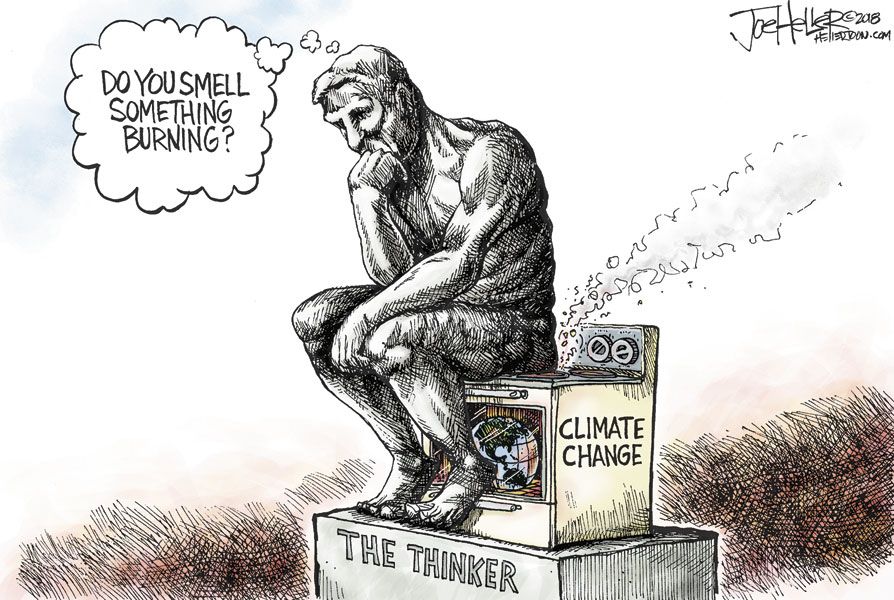Jonathan Overpeck: Climate change fueling western wildfire

By JONATHAN OVERPECK
Of the University of Michigan
Rains in Northern California finally helped firefighters contain this fall’s Camp Fire, which ranks as the deadliest in the state’s history.
Unfortunately, all signs point to worsening events ahead in the North American West. The risk extends well beyond California, and better forest management alone won’t solve the problem.
There are multiple reasons why wildfires are getting more severe and destructive, but climate change tops the list, notwithstanding claims to the contrary by President Donald Trump and Interior Secretary Ryan Zinke.
According to the latest U.S. National Climate Assessment, released Nov. 23, higher temperatures and earlier snowmelt are extending the fire season in western states. By 2050, according to the report, the area that burns yearly in the West could run two to six times larger than today.
The cumulative area burned by wildfire has greatly increased between 1984 and 2015. Analysts estimate climate change by itself accounts for a doubling of burned acreage.
For climate scientists like me, there’s no longer any serious doubt that human activity — primarily the burning of fossil fuels — is causing the atmosphere to warm relentlessly.
Climate change is driving a rapid increase in wildfire risk, and it has become a national problem. At the same time, healthy forests have become essential for the many valuable benefits they provide the nation and its people.
Neither more effective forest management, nor curbing climate change alone, will solve the growing wildfire problem. But together, they can.
Increasing wildfire risk is already the reality for much of the western United States, particularly California, the Pacific Northwest, the mountains of the desert Southwest and the Southern Rockies, where warmer temperatures and drier conditions are major contributors. As the climate continues to warm, elevated risks of forest stress and die-off, vegetation transformation and wildfire will spread across the United States.
Moreover, the problem is actually global in scope.
Studies show that climate change increases the frequency, duration and severity of drought.
As the past several fire seasons in California make clear, hot drought sets up wildfire risk like nothing else. And an unusually wet season doesn’t always help, since it can encourage excessive grass and other plants to grow, only to become highly flammable fire fuel when it dries out.
Climate change alters where snow and rain fall, and how long snow can persist, thus soaking into the soil. And plants dry out rapidly under hotter temperatures if rain and soil moisture can’t compensate.
As the planet warms, trees are weakening and dying at increasing rates, a trend that is clearest in California and New Mexico. As a result, climate-stressed vegetation is burning in unusually large, severe wildfires across the West.
Climate change also alters the zones in which plants can live successfully. As Earth’s climate changes, climate zones will shift around the planet, resulting in large-scale landscape change.
When vegetation is no longer growing in its preferred climate zone, the odds of disease, insect infestation, death and wildfire increase. Reducing those risks is necessary to make forests healthier.
The most extreme way to reduce wildfire risk would be to remove all vegetation from the landscape. So why don’t we just clear-cut forests? The answer is that they provide us with all kinds of valuable benefits.
People live near forests because they value natural views and recreation opportunities. Forests also store large quantities of carbon, so we need them in order to meet the goals of the Paris climate agreement, thus prevent the planet from warming even faster.
Healthy forests capture and filter drinking water for more than 68,000 communities across the United States. They also maintain biodiversity by providing habitat for numerous species of plants, animals, fish and birds. And of course, forests can provide wood products, tourism and other traditional services.
The challenge is to optimize forest benefits through innovative management techniques that can also help reduce wildfire risks. Often, intentional “prescribed” burns can be used to restore forests to a more natural, healthy state by reducing buildups of dead vegetation and underbrush.
Unfortunately, climate change is making some prescribed fires harder to conduct safely. And increasingly, people object to putting surrounding forests, buildings and communities at risk during prescribed burns and creating smoke that may affect those with respiratory issues.
Mechanical and hand thinning of forests can also improve forest health in some circumstances. But thinning is expensive, so forest managers need to find innovative ways to pay for it.
Experts have proposed expanding carbon markets to reward those who manage forests in ways that maximize the storage of carbon in vegetation and soils. Already, some Southwest communities, including Albuquerque and Phoenix, are subsidizing forest management to protect their water supplies.
Ultimately, protecting forests and taking action to slow climate change are complementary.
Innovative approaches to forest management will reduce wildfire risks in the near term and enhance many other services provided by forests and fire-prone landscapes. Over the longer term, curbing climate change — mainly by keeping fossil fuels in the ground — will ease the warming and drying trends that are making large parts of the United States so flammable.
These actions are necessary to improve safety, economic well-being and quality of life for people who live and work in fire-prone landscapes.
From The Conversation, an online repository of lay versions of academic research findings found at theconversation.com/us. Used with permission.












Comments
Don Dix
From the article --'For climate scientists like me, there’s no longer any serious doubt that human activity — primarily the burning of fossil fuels — is causing the atmosphere to warm relentlessly.'
'Relentless' -- quite a statement considering from Feb. 2016 to Feb. 2018 the temp 'dropped' .56 degrees C. The next largest 2 year drop was .47 degrees C in 1982 - 1984.
California wildfires -- besides the tree-huggers successfully blocking any attempt to clean up the forests (underbrush and deadfall is the fuel that causes fires to burn hotter and spread faster), 17 of the last 21 fires in Cal. have been started by power lines. Does global warming cause power lines to fail?
I find it quite exclusive when the science community that promotes AGW simply decides to ignore any fact that disputes the hypothesis that humans (read CO2) are causing the Earth to warm. Since 2000 the media has embraced the sensational (heat records), and produce very few articles when the temps set low records.
Add to this the fact (yes, a fact) that in every study (every) of ice core, ocean sediment, and tree rings, CO2 follows the rise in temps -- by an average of 800 years. And if CO2 is the driver of temps, how did the temp drop more than one half degree C in 2 years with CO2 levels growing? If the policy-makers and on-board scientists deflect critical facts, the truth is obscured in favor of political and financial orchestration.